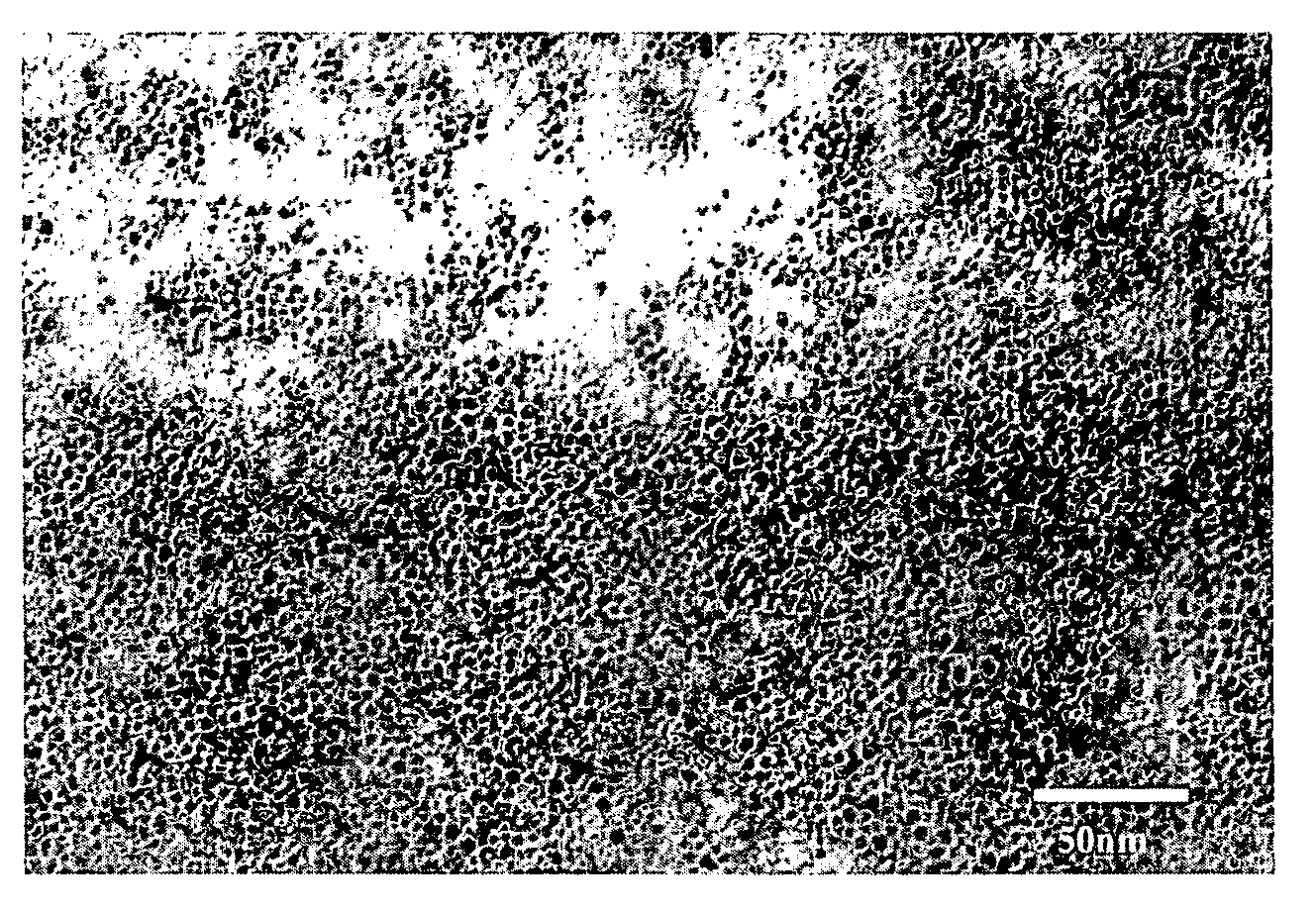Process for producing copper nanoparticles
a technology of nanoparticles and copper nanoparticles, which is applied in the direction of material nanotechnology, transportation and packaging, lubricant composition, etc., can solve the problems of not being suitable for lubricant industry use, prone to deformation, and difficult to operate more or less, so as to achieve higher dispersibility in an organic medium and stable
- Summary
- Abstract
- Description
- Claims
- Application Information
AI Technical Summary
Benefits of technology
Problems solved by technology
Method used
Image
Examples
example 1
[0021]An aqueous solution of copper acetate (5 mmol / L), an aqueous solution of hydrazine hydrate (50 mmol / L), and a solution of (O,O′)-di-n-hexadecyl dithiophosphoric acid in benzene (15 mmol / L, an extracting agent) were prepared respectively. At room temperature, the aqueous solution of copper acetate was quickly added to the aqueous solution of hydrazine hydrate at equal volumes to produce a mixture reaction system. The mixture reaction system was vigorously stirred and reacted. After 1 min, the extracting agent was added to the above reaction system at equal volumes to produce a mixture system. The resultant mixture system was stirred at room temperature for 1 hr and settled for 4 hrs. The organic phase was separated, filtrated and distillated to remove the solvent at 90° C. 200 ml of acetone was added to the distillated organic phase. The resultant system was stirred and a large amount of brown precipitate appeared. The brown precipitate was aged for 24 hrs, filtrated, washed fo...
example 2
[0023]An aqueous solution of copper sulfate (10 mmol / L), an aqueous solution of sodium borohydride (0.1 mol / L), and a solution of octadecyl dithiocarbonic acid in benzene (12 mmol / L, an extracting agent) were prepared respectively. At room temperature, the aqueous solution of copper acetate was quickly added to the aqueous solution of sodium borohydride at equal volumes to produce a mixture reaction system. The mixture reaction system was vigorously stirred and reacted. After 1 min, the extracting agent was added to the above reaction system at equal volumes to produce a mixture system. The resultant mixture system was stirred at room temperature for 1 hr and settled for 4 hrs. The organic phase was separated, filtrated and distillated to remove the solvent at 90° C. 200 ml of acetone was added to the distillated organic phase. The resultant system was stirred and a large amount of brown precipitate appeared. The brown precipitate was aged for 24 hrs, filtrated, washed for three tim...
example 3
[0025]An aqueous solution of copper acetate (1 mmol / L), an aqueous solution of sodium borohydride (5 mmol / L), and a solution of di-n-hexadecyl dithiocarbamic acid in hexane (1 mmol / L, an extracting agent) were prepared respectively. At room temperature, the aqueous solution of copper acetate was quickly added to the aqueous solution of sodium borohydride at equal volumes to produce a mixture reaction system. The mixture reaction system was vigorously stirred and reacted. After 1 min, the extracting agent was added to the above reaction system at equal volumes to produce a mixture system. The resultant mixture system was stirred at room temperature for 1 hr and settled for 4 hrs. The organic phase was separated, filtrated and distillated to remove the solvent at 80° C. 100 ml of acetone was added to the distillated organic phase. The resultant system was stirred and a large amount of brown precipitate appeared. The brown precipitate was aged for 24 hrs, filtrated, washed for three ti...
PUM
| Property | Measurement | Unit |
|---|---|---|
| particle diameter | aaaaa | aaaaa |
| particle diameter | aaaaa | aaaaa |
| particle diameter | aaaaa | aaaaa |
Abstract
Description
Claims
Application Information
 Login to View More
Login to View More - R&D
- Intellectual Property
- Life Sciences
- Materials
- Tech Scout
- Unparalleled Data Quality
- Higher Quality Content
- 60% Fewer Hallucinations
Browse by: Latest US Patents, China's latest patents, Technical Efficacy Thesaurus, Application Domain, Technology Topic, Popular Technical Reports.
© 2025 PatSnap. All rights reserved.Legal|Privacy policy|Modern Slavery Act Transparency Statement|Sitemap|About US| Contact US: help@patsnap.com


